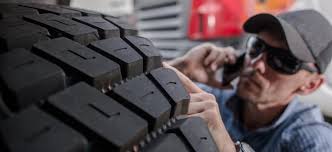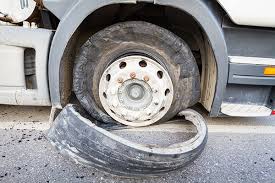How Often Should Semi Truck Tires Be Replaced?
On any vehicle, there are certain systems, parts and components that need to be closely monitored and regularly cared for in order to ensure that drivers stay safe while on the road. Tires are responsible for your vehicle’s traction on the road, and they become much less effective as they age and wear out. Because of this, it’s important that you regularly inspect your tires, monitor their air pressure and replace them when necessary. The problem is that a lot of truck drivers and owners don’t know how often they should have their tires changed or what signs to look for to determine whether replacement is necessary.
Mileage guidelines
Because every truck is different, and each semi will carry different loads and drive in different road conditions, there isn’t a reliably consistent guideline for tire replacement. Though mechanics and automotive experts don’t have a replacement recommendation that can be applied to all trucks across the board, you can generally expect to get 100,000 miles of drive or more out of a set of semi tires in Florida, since they are designed to be rugged and durable. Ultimately, without a universally accepted replacement guideline, the best way to ensure your tires stay in the best condition possible is to get routine maintenance and inspections.
Looking for signs of wear
Just like with regular vehicle tires, you can check for excessive wear with the penny test. If you place the edge of a facedown penny into the tread of your tires, you shouldn’t be able to see the entirety of Lincoln’s face. In addition to the penny test, you can also look for visible signs of wear. Perform a visual inspection to check whether the tread wear indicators in your tires are visible.
Along with tire inspection and replacement, make sure that you keep balance and alignment in mind. Replacing tires on one side of your truck, but not the other, will likely result in uneven wear and could lead to major safety and operational issues.
To keep your tires in the best condition possible, you should take your semi truck in for regular service and routine maintenance. A trained and certified technician will be able to accurately assess the condition of your tires and take care of any necessary patches, rotations or replacements. They can also advise you on steps that you can take to keep your tires in good condition through safe driving practices and preventative maintenance for your tires.

Difference Between Symmetrical & Asymmetrical Tires
The ribbed patterns on a vehicle tire are known as the tread design. These patters are carefully thought out by the tire manufacturer to perform well under the tire’s anticipated operating conditions. The tread design may be symmetrical or asymmetrical in nature.
Symmetrical Tires
Symmetrical tires have a tread pattern that is the same across the inner and outer portions of the tire.
Asymmetrical Tires
Asymmetrical tires have a tread pattern that is different across the width of the tire. When looking at an asymmetrical tire the inner and outer tread patterns will not be the same.
Benefits of Symmetrical Tires
Most non-high-performance passenger vehicles will use symmetrical tires. Symmetrical tires are typically quiet and long lasting. Their tread patterns allow them to be rotated in many different ways, which substantially increases the life of the tire.
Benefits of Asymmetrical Tires
Asymmetrical tires are designed with vehicle performance in mind and are commonly found on sports cars. Asymmetrical tires have large blocks of tread on the outside to increase cornering stability and narrower blocks of tread along the inside of the tire to aid winter or wet weather driving.
Warning
When replacing a vehicle’s tires, never mix symmetrical and asymmetrical tires on the same vehicle. Mixing these two types of tires may cause the vehicle’s handling to become unstable, particularly in wet weather.

Best Options for a Lifted Truck
If you’re thinking about lifting or leveling, it sounds like you enjoy adding some personality to your truck. Why have it look like all the others? If you’re willing to get your hands greasy, consider these other options while you have your truck jacked up in the garage.
TIRES AND WHEELS
When you lift a truck, you open up your options. A factory-spec truck usually takes tires that measure up to 33 inches. A lifted truck can take tires up to 37 inches. Before proceeding, be sure to measure your old tires and the wheel wells, along with the distance between the tire and hard parts when the wheels are fully turned left and right. That way you can avoid having your new tires hitting the wheel well while you’re driving.
What’s the advantage of bigger tires? Obviously, there’s the jacked-up showroom look that many truck enthusiasts love. Also your truck will also go faster, since every revolution of the tire covers more ground. You may want to recalibrate your speedometer for exactly that reason. If you opt for wider tires, you may find you have better handling and performance. One slight disadvantage is that your fuel economy will suffer slightly because bigger tires add weight and rolling resistance.
ENGINE AND EXHAUST
If you’re lifting your truck for better off-roading, you also might consider upping your performance. A cold air intake pulls air from outside directly into your engine. Like fresh oxygen to a fire, this provides better combustion. That means the engine doesn’t work as hard, providing better horsepower and torque.
You can also try your hand at tuning your truck. Tuning means adjusting the settings on a truck’s electronic systems. Why do that? Factory settings don’t usually optimize performance or fuel economy. Manufacturers usually take a middle-of-the-road approach, programming the truck to have general appeal or meet government or company standards. When you tune, you can mold the truck to function the way you like by changing the electronic systems to your specifications, not anyone else’s.
SUSPENSION
When lifting, your hands will be on the suspension of your truck anyway. Let’s see what options you have there. If you want to enhance your off-road performance, you’ll be interested in installing some performance shocks. Leaf kits allow you gear your truck to off-road adventures, and purpose-built springs in the link system can help you change up the cushioning system to either get a stiffer or softer ride across various types of terrain.
DRIVETRAIN
If you notice more vibration after lifting your truck, you may have to replace your drivetrain. Your old U-joint-style driveshaft might need to be replaced with a double cardan or CV joint that can operate smoothly at higher angles.
ACCESSORIES
Here’s where your lifted truck gets really fun. When you’ve taken care of the logistics and made sure the guts of your lifted truck are in shape, look at accessories. Lifted trucks can add an extra layer of utility with things like lights (opt for light bars, strobes, square lamps, flood or spot to help you in the backwoods), winches (which can help you get out of some seriously sticky or sandy situations), and storage racks. Want to protect your undercarriage? Armor can help the rocks bounce off without damage.

TRUCK TIRE SIZES EXPLAINED
typically starts with a letter indicating the type and ends with a two-digit number, giving the rim size. Between these parts, you will see additional information about the tire size and construction.
1. TIRE TYPE
The first letter represents the type of vehicle you should install the tire on. P indicates a passenger vehicle or light-duty truck. Generally, these tires require lower pressures than other tires. LT designates a light-duty truck, but these often accompany larger 3/4 and one-ton pickups. If there is not a letter at the beginning, the tire is a Euro-Metric tire, usually used on passenger vehicles. In the example P235/75R15, the P means this tire fits onto a passenger vehicle.
2. SIDEWALL WIDTH
Look at the three numbers after the letter or the first three numbers in front of a slash mark if your tire does not have a letter at the beginning. These numbers give the measurement of the tire’s width from sidewall to sidewall in millimeters. Most tire measurements come from the metric system, regardless of the company making the tires. The example of P235/75R15 has a width of 235 millimeters between sidewalls.
3. ASPECT RATIO
After the slash mark, you will see a two-digit number. This value refers to the aspect ratio, which is the percentage of the sidewall’s height to its width. In the example tire, P235/75R15, the 75 is the aspect ratio. This tire’s sidewall height measures 75% of the width of the sidewall.
4. TIRE CONSTRUCTION
Following the aspect ratio, you will see one of three letters — R, B or D. This letter tells you about the tire’s construction. An R designates radial tires, which have their internal cords laid at 90-degree angles to the tire’s centerline.
Bias-ply tires have a D in this position to indicate their diagonal design. On these types of tires, the cords cross each other at 30 to 45-degree angles. While once common early in the 20th century, bias-ply tires no longer dominate the market. They have been replaced by longer-lasting, more comfortable radial tires.
Belted tires have a B to designate their format. These tires mix the diagonal design of bias-ply with added belts inside the construction. While rare, these have applications on some off-road trucks, trailers and antique vehicles.
For the example used, P235/75R15, the R means its construction is radial.
5. WHEEL DIAMETER
While the sidewall width uses millimeters, the wheel diameter, the last digits after the construction letter, comes in inches. The larger the number here, the larger the wheel size. If you replace your rims, you will also need to change the tires to fit. Be careful when changing wheel sizes because larger wheels affect the handling of the vehicle.
In the example tire, P235/75R15, the 15 at the end means you must install it on a 15-inch diameter wheel.
6. LOAD INDEX AND SPEED RATING
Following the size information, you will see two numbers and a letter. The numbers give the load rating for the tire, while the letter indicates the speed rating.
Using P215/65R15 85H as an example, the 85 gives the load index, also called the tire ply rating, and the H is for the speed rating, which tells you the maximum speed at which you should use the tires. This speed ranges from 3 mph to 186 mph.
HOW TO READ A TIRE
If you take a close look at a tire, you will find a large amount of information. Everything from the manufacturer’s name to the tire size and load rating appear on the sidewall. Interpreting these numbers requires you to know what values to look for and their meanings.
On the sidewall, you will find the tire’s type, the width, aspect ratio, construction, wheel rating, load index and speed rating. You can identify the values based on their position relative to each other and how many numbers or letters they have. The Tire and Rim Association standardizes these values for all American tire manufacturers.
Some tires may also have Uniform Tire Quality Grading, UTQG, which refers to information for traction and temperature grades. AA traction grades perform best in wet conditions, and the classes go down in performance — AA, A, B and C. Temperature categories refer to how well the tires dissipate heat at various speeds. Those rated with A perform well at speeds over 115 mph. B-rated tires operate best between 100 mph and 115 mph, while C tires remove heat best at speeds between 85 mph and 100 mph.
The first part to look for is the string of letters and numbers that may start with P, LT or no letter. For example, P235/75R15 or LT215/65R15. Manufacturers put a lot of information into this alpha-numeric code — the tire type, width, aspect ratio, construction and tire diameter.